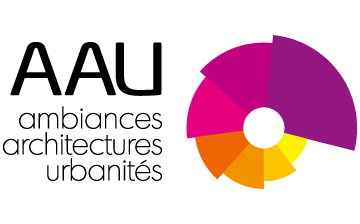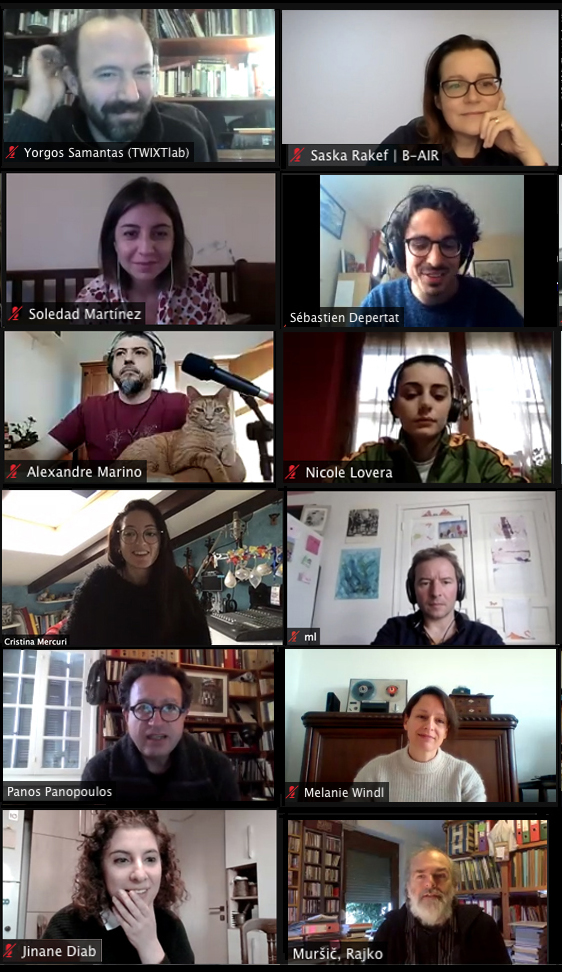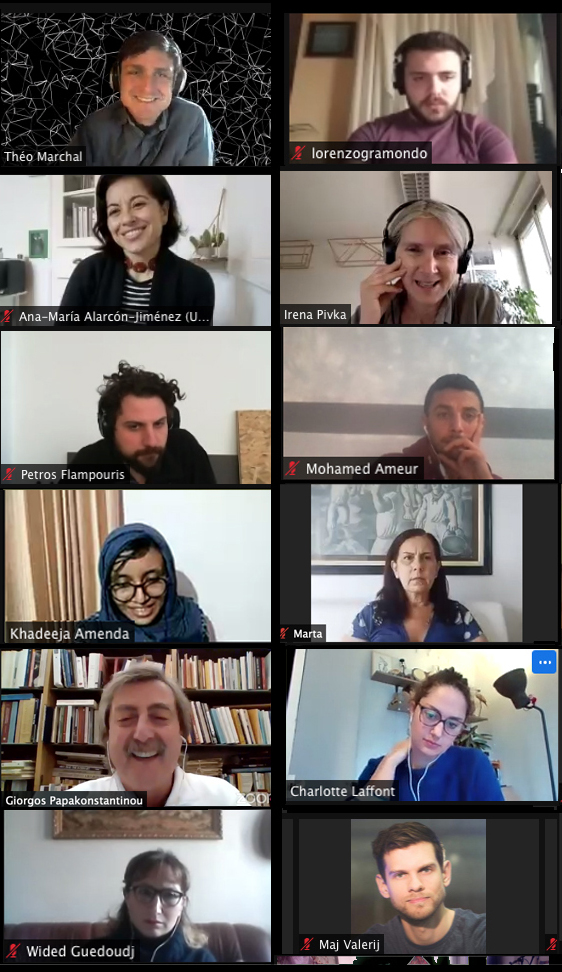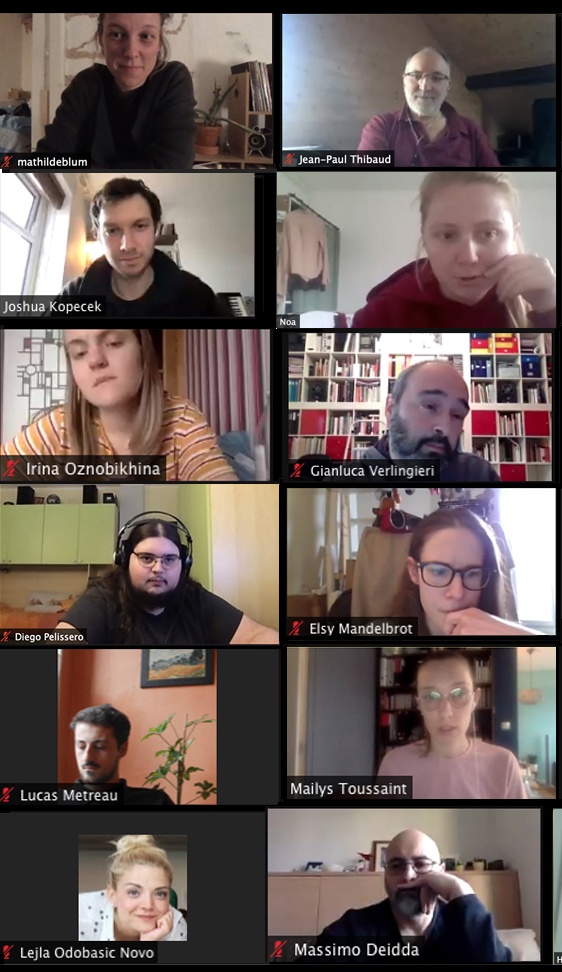Ecole d’hiver – Winterschool 2021
|
The 9th winter school organized by CRESSON is welcoming this year the « B-AIR Art Infinity Radio » project supported by the Creative Europe Culture Program (EACEA). As since 2013, the CRESSON winter schooltakes the form of a week of research and practices in order to discuss and explore the laboratory’s methods and concepts in their capacities to give some answers to a specific topic in link with the sound environment, its study and its transformations. This year the theme is “vulnerabilities and sounds, the experience of listening”. In a world where the immediacy of information as well as the quickness of actions have become the rule, it seems more and more challenging to take the time. The acceleration of lifestyles and ways of thinking has become a prerequisite for success. Nevertheless, in parallel with this fast-moving world, long-term issues are being increasingly neglected, creating social, environmental and spatial « vulnerabilities ». It is precisely at the intersection of these stakes that the question of ambiances and more particularly of sounds can appear as a catch. Listening to the environment, a gesture that may seem simple and insignificant, becomes a powerful tool for considering places and words at scales and temporalities that are difficult to reach with the visual. Sound is a medium intrinsically related to time, but also very capable of questioning scales that are often « left aside » because they appear to be too obvious, too small or on the other hand too large. Therefore, sound could be considered as a lever for considering, questioning or reframing these issues. * * * The Winter School will be held this year both in Grenoble (École Nationale Supérieure d’Architecture de Grenoble) and in Volos, Greece (Department of Architecture, University of Thessaly). This event is funded by the « B-AIR Art Infinity Radio » project, one of the winning projects of the European call of the Culture Program of the European Agency for Culture, Education and Creation (EACEA). * * * General Chair : with * * * Some pictures
* * * |
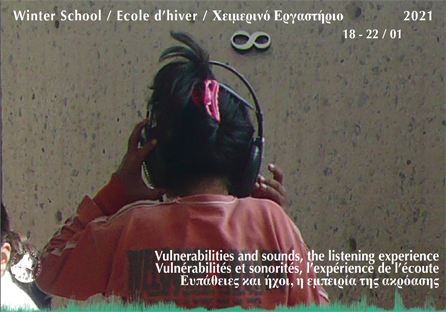
Programm & recordings
Monday 09:00 – 09:30
Monday 11:00 – 11:50
Since the first works of Pierre Schaeffer (The Sound Object 1966), then Murray Schafer on the soundscape (1977), completed by the collective work of Cresson (sound effects 1995), many are now the concepts likely to describe the sound phenomena as they are experienced and produced daily. These works make it possible to describe sonic phenomena on different scales: scale of the sonic sources with the sound object, scale of the body in movement with the sonic effect and scale of the landscape with the soundscape. They articulate perfectly to the attention that we have when we are listening to sound and acting with them. They are also very meaningful and relevant to describe affects produced on the listening and acting subject. They become operators for sound creators (installation, sculpture, radio arts, musical arts) but also for space designers (artists, architects, urban designers). Nowadays, with the revival of the general interest for sound (sound studies), the notion of sonic effect seems the most promising tool to describe our contemporary practices with the sonic environment. Vulnerability of spaces, vulnerability of the environment and vulnerability of social practices will be discussed regarding the sound effect notion. Monday 13:00 – 13:50
Tuesday 09:00 – 09:30
The presentation will explore what could be an atmospheric listening to lifeworlds. It is placed under the sign of the Phonocene (Haraway) and the Phonotop (Sloterdijk). The aim is to understand how sonic experience maintains a fundamental relationship of vulnerability to the world. Atmospheric listening pays attention to the attunements and resonances of any situation, and gives existence to the diffuse, precarious and discreet efficiency of the world of sound. Tuesday 10:00 – 10:50
How does the notion of “infinite places” allow us to question the production of contemporary architectural space? What are the new challenges for the design of the atmospheres of these new forms of public space? This article aims to bring together the urban practices identified by the Encore Heureux collective with a praxeological thought of the creation of atmospheres. Infinites places are analyzed in their potentials to create infinite conflicts, infinite negotiations and infinite sympathies between the back plan and the emerging events. Vulnaribilities of spaces and listening will be discussed in this frame. Tuesday 11:00 – 11:50 In the key of life: the place of sound in the anthropology of Tim Ingold.The anthropological thought of TimIngold is a thought that has been shaped in dialogue; with the Sami communities he lived with during his fieldworkin the 70s and 80s, with the empirical and theoretical richness of the anthropological tradition, with thephenomenology of Merleau-Ponty, Jonas and Heidegger and the pragmatism of Dewey, with evolutionary thoughtin biology and archaeology, with practitionersand theorists in the crafts and arts, in architecture and design. Atthe heart of these dialogues is a concern for understanding how we inhabit the world, how human forms of life arenegotiated with this world in all its material and living diversity, andhow understanding this negotiation requires aprofound re-writing of Western notions of the individual, knowledge and action. This intervention reads Ingold’sbody of work through the question of sound and its role in opening up social life-what it is and what it could be-to thought and action. Tuesday 19:00 – 20:00 Invited Conferences
Wednesday 09:00 – 09:30
On the limits of sound art as a socially engaged art practice In this presentation, we will investigate how sound can function as a weapon/tool towards social inclusion, and problematize the aspects of recorded sound as a technical object. Further, we will draw upon the notion of “synaesthetic translation”, in order to sketch a genealogy of the interchangeability of modalities between art forms or genres, from Benjamin or Schoenberg and Kandinsky to contemporary art and new media applications. Last, we will pose some initial research questions as framed within “Audibility”, (part of “B-Air” Creative Europe project) that invites Deaf or Hard of Hearing students in sound-art and radio-art processes. Wednesday 10:00 – 10:50 Deaf / Sound / Art The ways of the deaf with sound reveal the significance of deaf sonic and vocal experiences towards a wider understanding of perception, expression and creativity, both for the deaf and the hearing. The presentation will focus on the relations of the deaf with sound, through vision, voice, touch and vibration, especially as these relations materialize in the work of contemporary artists working on deafness and on alternative sonic perception, or by deaf artists working with sound and voice. I will further refer to my research collaborations (ethnographic/ artistic experimentations with deaf and hearing artists), which focus on a systematic exploration of crossovers between artistic work and anthropological research on sound. Wednesday 11:00 – 11:50
Walking as the principle of analogue attunement of mind and movement, as a political act, used today – more than ever – to implicitly express our view on the evaluation of time. Going places on foot is a waste, yet simultaneously a gift of time. Claiming time to move whereby remaining one own’s metronome. In the lecture announced authors will delibelatery focus only on their own artistic creations. The presentation will cover their latest performative works, which connect them with walking, listening and using locative media tools, works that are based on the sound field recordings and reflections on the social relations towards society and nature. Through acoustic ecology, the authors want to highlight the perception of our environment, listening and walking as a possible forms of artistic activity, which is extremely important in today’s dramatically changing state of social and cultural landscape. Wednesday 12:00 – 12:50
RadioTeatar attracts artists from different contexts and generations: radio, theater, music and film artists exploring the points of connection and overlapping of their specific practices with radio practice.
Thursday 09:00 – 09:30
The aim of my presentation is to shed light on the effects of music listening on psychological wellbeing. The presentation is going to be grounded on psychological concepts such as functions of music listening, music preferences, psychological well-being, coping with stress, and experiencing flow. The leading questions I’ll try to answer during the presentation will be as follows: (1) How do different elements of music, such as tempo/rhythm, tonality, musical genre, lyrics, etc. affect listeners’ wellbeing, (2) when, where, and how to listen to the music to promote wellbeing, (3) how to promote the therapeutic value of music in listening to music for the vulnerable groups of people? With regard to the latter, I’m going to present a project, developed and launched by Radio ARS (Slovenia) in collaboration with different experts during the first COVID-19 pandemic lock-down in Slovenia. The mentioned radio literature-music show was developed to enhance wellbeing in elderly people in retirement homes. Thursday 10:00 – 10:50 In classical ethnographic report on life at the Trobriands, Bronislaw Malinowski described the institution of bukumatula, the house for the youth, where they would socialize and have first independent life experiences, among them sexual. Having in mind the school, the youth in the west would not have such privileged spaces for socialization. Nevertheless, the youth and younger generations would find their way in occupying public urban space: flaneurs in “decadent” Paris; jazz-dancing audiences in swinging 1930s in USA and Europe; unstoppable rocking’ youth after the 1950s, and partying ravers till the present. The author will present importance of the venues for youth and younger audiences, based on his long-term study of specific grassroots music venues, i.e., alternative music venues, squats and underground venues in Slovenia after WW2. In the last two decades, with the rise of neoliberal capitalism, these venues are in decline. Their essential social importance is in sharp contrast to rising privatization of space. The main point of the presentation will be that they are not obsolete, because they cannot compete with private interests, but, on the contrary, they are fought against as one of eventual counter-powers: they are actually the new commons in space. They are specific commons, spaces of experiencing something we might define as communist, producing spatial, social, auditory and acoustic commons. These venues literally create new common spaces in which sounds of music define new forms of socialness. Thursday 11:00 – 11:50
I have been teaching composition for many years but the vast majority of my students do not study to become composers but rather music and instrument teachers or even sound technicians. Often the teaching of composition is seen as a rigorous technique that is expressed in a list of prohibitions: a necessary choice to train professionals in composing. I prefer to interpret composition (and words) as an inventive and creative opportunity: between the etymology of the Latin cum ponere=to put together, Edgar Varese’s concept of organized sound, playing as a game and the music score as the score of this game. My students are mature musicians: each has their own cultural, musical and life background. The challenge for me, as a teacher, is to make them understand that they are already composers by putting together, in an inventive gesture, what they already know. I hope that they, as teachers, will then do the same with their pupils. The aim is not to train professional composers but to make them understand that not only performing but also creating with sounds is a great making music; and it can be good for people, whether they are musicians or not. Thursday evening
Friday 09:00 – 09:30
By studying the inhabitant’s daily experiences during the rehabilitation of their building through qualitative methods of inquiry, this research aim to understand the habits and the habituations process of inhabitants in Friday 10:00 – 10:50
Based on reflections on the evolution of our listening to the environment since the COVID-19 pandemic, Charlotte Laffont will outline a definition of vulnerability in the environment. She will consider the place of nature, but especially of agriculture in cities, as a hypothesis of response to this Friday 11:00 – 11:50 Beirut, heterogeneity and struggle of ambiances in enclosed neighbourhoods Based on the complex community and societal context of Lebanon and above all of its capital Beirut, this thesis questions identity conflicts and what arises from a struggle of ambiences in two irregular neighbourhoods of Greater Beirut. The districts of « Ouzaï » and « Karm El Zeitoun – Syriac » are made up of heterogeneous ambiences and identities, conceived due to different uses and activities. Today surrounded by a speculative urban transformation, how can we imagine their future? The thesis will be based on situated work and surveys to update the constitutive elements of this « heteroclicity ». What possible role is for ambiences in future evolutions of these neighbourhoods? To make heritage / to make a project for la Capuche, l’Abbaye and Jean Macé This research project questions what makes heritage in three neighborhoods of low-rent housing in Grenoble built during the period from 1920 to 1930: l’Abbaye, la Capuche and Jean Macé. These neighborhoods originally shared a number of similarities in terms of their construction, however they went through a number of transformations. We consider the hypothesis that what makes heritage consists of three patrimonial values: historical value, usage value and the value of renewal. What makes heritage stems from a common interest for the vitality of these neighborhoods and the population who « invented » them by their real-life experiences and their stories. From the inhabitants narratives, we will question the social vulnerabilities of these neighborhoods through a focus on sound.
|
Conclusion :
